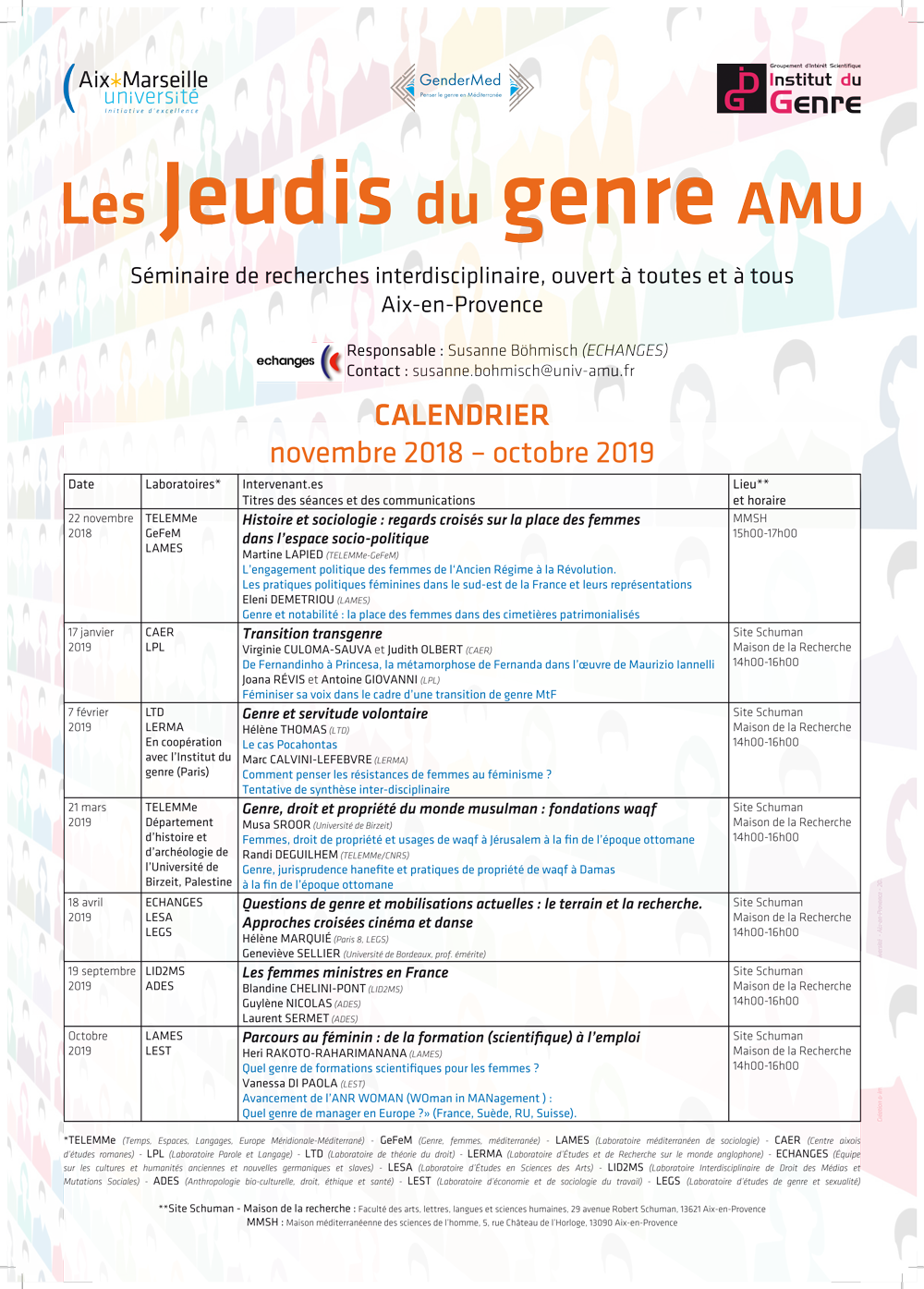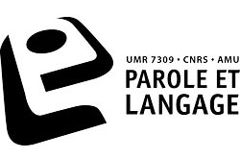
Title : Regards sur la négation et les dépendances négatives
(Presentation in French about “Looks at Negation and Negative Dependencies”)
Viviane Déprez
DR, CNRS, Institut des Sciences Cognitives Marc Jeannerod
Laboratoire Langage Cognition et Cerveau (L2C2)

Seminar
March 1st 2019, 10.30 a.m. at A003
Laboratoire Parole et Langage
***
Aron Arnold
Les pratiques de séduction vocale, et ce qu’elles nous apprennent sur le genre
Les rituels de séduction mobilisent un ensemble de pratiques, verbales et non-verbales, à travers lesquelles les actrices et acteurs sociaux se présentent d’une certaine manière et rendent intelligibles différentes émotions, attitudes et intentions. Une expérience, s’inspirant de Puts (2005) et Hodges-Simeon et al. (2010), basée sur des simulations d’appels téléphoniques, nous a permis d’étudier les pratiques vocales de 30 locuteurs – 15 femmes et 15 hommes – francophones de la région de Bruxelles et du Brabant wallon en contexte de séduction. Nous avons constaté que ces derniers, lorsqu’ils avaient comme consigne de s’adresser à une personne qu’ils souhaitent séduire, tout en prenant une voix qu’ils considéraient comme « séduisante » et « sexy », (1) abaissaient leur fréquence fondamentale, (2) réduisaient leur débit de parole, et (3) augmentaient la fréquence du second formant (F2) de certaines voyelles, vraisemblablement par des sourires. Nous interprétons ces variations, d’une part, comme relevant d’une stratégie à travers laquelle les locuteurs montrent leur attirance envers leurs interlocuteurs – car pour séduire, il faut être séduit (Baudrillard, 1979, p. 112), ou du moins prétendre l’être. Et d’autre part, comme une stratégie pour indexer leur assurance et leur confiance en soi. L’étude de ces trois paramètres n’a pas révélé de différences signifiantes entre locuteurs féminins et masculins – les mêmes tendances ont été observées auprès des deux groupes. En revanche, nous avons remarqué des différences de genre dans la manière dont notre expérience a été appréhendée. Lorsque nous avons demandé aux locuteurs de produire une voix « séduisante » et « sexy », les locuteurs féminins ne manifestaient généralement aucune difficulté dans la compréhension de la tâche, ni dans la production de ce type de voix. En revanche, les locuteurs masculins expliquaient régulièrement qu’ils ne comprenaient pas la consigne, ou qu’ils ne savaient pas comment produire une voix de ce type. Nous interprétons cette différence comme une conséquence du fait que les femmes sont plus sexualisées que les hommes, et que conséquemment la séduction féminine est davantage stéréotypée que la séduction masculine.
***
Maria Candea, James German, Mariapaola d’Imperio
Présentation du projet ANR NoBiPho 2019-2021: La production et la perception de la voix et de la parole comme sites de (de)catégorisation du genre: vers l’émergence d’un paradigme non-binaire
Contact: Oriana Reid-Collins

Friday, March 15, 2019 at 11 a.m.
Seminar by Jody Kreiman, Professor at UCLA and internationally renowned expert in the field of voice.
What is voice quality and how should we measure it?
This old question has been debated for decades, but still remains unanswered. In this talk I will argue that voice cannot be studied as a concatenation of separate research on production, acoustics, and perception, but must be considered as a single communicative process in which each piece interacts with and depends on the others. Then I will revisit our psychoacoustic model of voice quality, and present some current research from our lab applying this model to explore within-talker variation in voice and the links between voice production and perception.
Contact: Caterina Petrone

AMU gender Thursdays
Interdisciplinary research seminar, open to all
Contact: susanne.bohmisch@univ-amu.fr
The next session on January 17 will include two members of the LPL, Joana Revis and Antoine Giovanni for an intervention on “Feminizing her voice as part of a gender transition MtF”.
The session will take place from 14h to 16h, at the Maison de la Recherche, Schuman Campus.
Full program of Gender Thursdays AMU

Seminar of January 18th, 2019, 11 a.m., room B011 at the LPL
Denis Guthleben
Historian, member of the Committee for the History of the CNRS

Seminar of January 10, 2019, 14h, in room B011 at the LPL
Pascal Taranto
(Gilles Gaston Granger Center)
LABΩ: platform for the realization of collaborative thematic projects
Summary :
New concept of online research platform for the realization of collaborative thematic projects in the field SHS in particular, LABΩ allows to start quickly and to carry out a research program mobilizing virtually an international network, multidisciplinary and multilevel (of the enlightened amateur to the PR through the doctoral student) without having to look for funding but only on the basis of the scientific interest of the project.
LABΩ is both:
1. an incubator for scientific projects and a nursery for calls for projects;
2. a hub of services and tools currently scattered on the net and under-used or poorly known (bib inist, cat inist, HAL, translators, ISTEX, visios, etc.) all of which will be available in one click on the platforms LABΩ
3. A data generator open editions for research.
4. Potentially a new doctoral training process
The project aims to produce baseline results through a collaborative process that allows for an accurate assessment of the quality of individual contributions. Five pitfalls of current research are targeted:
• the standardization of SHS projects by the call for projects policy as it is currently conceived,
• the loss of time and public money generated by this process (1.5 out of 10 projects are selected while 40% are rated A)
• the demobilization of researchers,
• the decline in the quality of the scientific level by the pressure to publish
• and the great difficulty of objectively evaluating the results of the research.
This project is financially supported by SATT-SE and the PACA region, and will be presented at Innovatives SHS 2019.

Seminar of January 11, 2019, 11 a.m., conference room B011 (LPL)
Matthijs Westera
(University of Amsterdam)
Intonational Compliance Marking: a theory of English intonational meaning
Here’s a conceptually simple theory of English intonational meaning that seems to work well for a number of empirical phenomena. It’s basically the old idea that rises mean ‘incompleteness’ and falls ‘completeness’, but made significantly more precise by considering what it means for an utterance to be ‘incomplete’ or ‘complete’. I define these notions in terms of (non-)compliance with the conversational maxims. To illustate: plain rising declaratives can express uncertainty about the truth (Quality), relevance (Relation), sufficiency (Quantity) or manner (Manner) of the utterance, that is, potential non-compliance with each of the Gricean maxims. I call this theory Intonational Compliance Marking (ICM). In this talk I’ll summarize the ICM theory and its application to rising declaratives (Westera, 2018), the rise-fall-rise contour (Westera, to appear), and, time permitting, list intonation and question intonation. In each case, precision about the maxims is what makes this (at the outset) simple theory generate fine-grained predictions. I hope that this work can inspire research on intonation in English and cross-linguistically, as well as on discourse particles and on pragmatics more generally.
Westera, M. (2018). Rising declaratives of the Quality-suspending kind. Glossa: A Journal of General Linguistics, 3(1), 121. DOI: http://doi.org/10.5334/gjgl.415
Westera, M. To appear. Rise-fall-rise as a marker of secondary QUDs. In Daniel Gutzmann & Katharina Turgay (eds.), Secondary content: The semantics and pragmatics of side issues. https://www.dropbox.com/s/zukzbj0jqcxfpln/
Contact: Cristel Portes

















